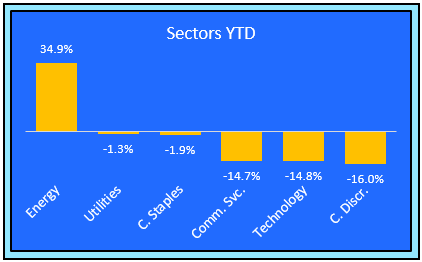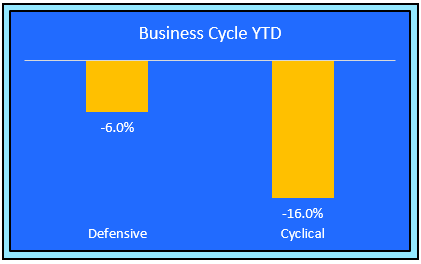Market Recap - Follow the Money is a series of brief, information-rich posts that I will publish periodically but not on a fixed schedule. I rely on charts to do the heavy lifting and I keep my commentary to a minimum.
If you're like me, you prefer to visualize facts and figures rather than reading about them in a long article. That's why I use charts and tables instead of dull, tedious prose.
I also like to keep things as simple and on-point as possible. When I read an article that wanders off in several different directions before arriving at the ultimate payoff (assuming that there is one), I usually chalk it up to the author's need to meet a word-count quota. I will make these posts as long as they need to be, and no longer.
Chart 1. Major Markets
I divide the global equity market into 7 segments - U.S. Total Market, U.S. Small Cap, NASDAQ, Foreign Developed, Europe Developed, Asia Large Cap. and Emerging Markets. As with all the charts, I show the year-to-date return. You can follow the money as it moves among these seven segments.
Emerging Markets are outperforming the rest of the world, due in large part to windfall profits in the commodities-exporting countries of South America and the Middle East.
If you want to follow the money, this is a good place to start. It looks like a durable trend. A well-diversified portfolio will have a significant exposure to Emerging Markets, as well as some exposure to Asia and Europe.
Chart 2. Market Sectors
Of the eleven primary market sectors, this chart shows the top three and bottom three performers. I do it this way to keep things simple. Money has been flowing out of tech, consumer discretionary, and communications services, and into energy, utilities, and consumer staples. This trend will probably continue as long as there is uncertainty about the possible resolutions of the Russia-Ukraine war. Demand for oil & gas remains high, the global economy is about to take a hit to growth. and inflation will continue to rise until energy prices begin to break down.
Chart 3. Styles - Growth vs. Value
After slightly underperforming growth last year, value is where the money is flowing. I see this as another durable trend. Growth has been hit hard by the slide in tech stocks this year.
Chart 4. Size
Small caps are still lagging. After underperforming last year, they are struggling to keep up this year. Mid caps were almost tied with large caps last year, and the are in the lead this year. The flow of money from large caps to mid caps looks like a durable trend.
Chart 5. Factors
There are more than 100 factors to choose from, so I had to cut the list to just six, in order to keep this chart reasonably easy to digest. Quality is getting pummeled this year after a stellar 2021. Mean reversion at work.
The top performing factor so far is dividend yield. I'm not sure about the durability of this trend, because rising bond interest rates will begin to compete with dividends at some point.
The bottom performer is Quality. This factor includes companies with strong and growing earnings, and growth is at least temporarily out of favor.
Chart 6. Sensitivity to the business cycle
In this chart I divided the market sectors into two groups - those that respond more vigorously to the changing phases of the business cycle (cyclical), and those that respond less vigorously (defensive).
With the economy still in growth mode, cyclical stocks should do better than defensive stocks. That hasn't happened yet this year, and maybe the market is sending a signal that the economy isn't as strong as many would like to believe.
The flow of money away from cyclicals and into defensive looks durable.
Chart 7. Bonds
I threw bonds into the mix because I think it might be interesting to watch how the various flavors of bonds react to Quantitative Tightening. So far it looks like convertible bonds are seeing the most outflows. That's understandable, given their high starting valuations and their equity component.
Keep an eye on junk bonds, because they are especially vulnerable to an economic slowdown. If they continue to lose momentum, the risk of recession will increase.
Chart 8. Countries
There are 50 countries that are represented by ETFs. Here are the top and bottom performers YTD. It looks like South America is having a resurgence this year, while Europe is struggling with geopolitical issues and heavy sanctions - both imposed and threatened.
I removed Russia from this chart because their stock market is essentially closed to outsiders. At last count, RSX - the Russian ETF - was down by 78% and falling.
Final thoughts
We're only 43 trading days into 2022 and these trends will undoubtedly shift as the year progresses. By keeping an eye on money flows among these categories, you can gain some insight into what could be a durable trend, and what's just noise.
The trends that look the most durable to me at this time are foreign vs. US, value vs. growth, mid cap vs. large and small cap, defensive vs. cyclical, and commodities - especially energy - energy vs. tech.
My preference for foreign vs. US is already being challenged by the Ukraine war. European and Asian economies seem more vulnerable to the fallout from sanctions against Russia. The rest of the trends I've identified are more durable than that.








